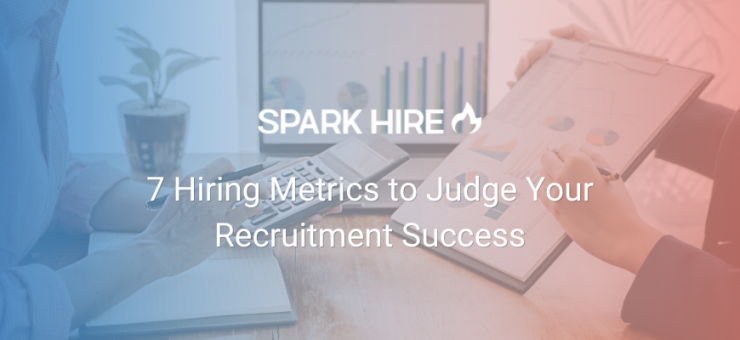Knowing your hiring metrics is key to understanding if your hiring and recruitment efforts are paying off.
When you know your metrics you can accurately predict how long it will take to hire new candidates, how many candidates you can expect to attract based on budget, and how effective your overall hiring process is.
Let’s dive into some of the most important hiring metrics you can use and track to understand your hiring performance, identify problems, and spot areas you can optimize:
What are Hiring Metrics?
Hiring metrics are data points and performance indicators that show you how effective your hiring efforts are.
Different hiring metrics apply to different stages of the recruitment pipeline – from initial candidate outreach to bigger-picture overviews of your entire hiring process. If you look at these hiring metrics together, they can help you make better hiring decisions, set realistic targets, and improve your recruitment workflows.
Why Tracking Your Hiring Metrics is Key
Being data-driven is key to hiring success.
Optimizing your hiring process using real data will help you improve your recruitment marketing, and interview process, and ultimately, ensure you’re only hiring the very best candidates for your open roles.
You can also use your hiring metrics to demonstrate your wins to management and make a case for expanding your recruitment team or investing more capital into your part of the business.
In the next section, we’ll show you some of the key hiring metrics you can track to understand how successful your hiring process is.
7 Essential Hiring Metrics to Track and Improve Your Hiring Process
1. Job Application Completion Rate
When you’re advertising your open roles, interested candidates will need to fill out an initial application form.
The rate at which candidates fill out their application forms compared to the dropout rate gives you an indication of how easy it is to complete your application process.
To calculate it, use the following formula:
(Total number of form completions / Total number of application forms started by applicants) * 100 = Job application completion rate (%)
In most cases, you want to find a balance. For example, you don’t want a 70%+ application completion rate, because adding friction to the process helps you filter through motivated candidates.
On the other hand, if you’re only seeing a 3% application completion rate, you know something is too difficult to complete in your application process. You may have included too many form fields, or not be following application form best practices that hurt completion rates.
Simple ways to improve your job application completion rate are:
- Letting people automatically register using their LinkedIn account
- Don’t ask candidates to re-type information included in their resumé
- Make sure each part communicates why it’s required
Your candidates don’t want to spend too long applying even if they’re interested in the role because, at this stage, they won’t have even had a conversation with you.
2. Recruitment Outreach Response Rate
If you’re hiring for a senior role, you’ll want to ensure you’re not leaving the hiring process to chance and you find the best person for the role.
To do this, you’ll run outreach campaigns to qualified candidates using LinkedIn Sales Navigator and via cold email and let them know about the role that you’re hiring for.
To calculate your recruitment outreach response rate, use the formula:
(Total number of replies / Total outreach messages sent) * 100 = Recruitment Outreach Response Rate (%)
If you can run campaigns that get a high response rate, you’ll be able to have conversations with qualified candidates and let them know why they’d be a perfect fit for the role you’re hiring for.
Most cold outreach platforms will let you track your recruitment outreach response rates automatically, which makes reporting simple, so you know how many candidates are getting back to you. You can then use this data to improve your email copy and boost your response rates moving forwards.
3. Average Time to Hire
Having a low average time to hire ensures you’re able to keep up with the growth of the company and no one department is ever waiting too long for new hires.
To calculate the average time to hire, you need to know how long it took to hire for various roles. For example, if you had one role that took 20 days to fill, another that took 40, and another that took 60 days, you’d use this formula to find the average:
20 + 40 + 60 / 3 = an average time to hire of 40 days
If you have a low average time to hire, it shows that your hiring process is streamlined and effective.
On the other hand, if your average time to hire is too long, it’s a sign that your hiring process isn’t as efficient as it needs to be.
You can bring down your average time to hire with actions like:
- Setting clear criteria for what makes a good hire ahead of time
- Creating a deadline for when you need to hire someone matching your ideal hire criteria
- Having contracts and documents your new hire will need to sign ready before you find the perfect candidate
- Improving your candidate prospecting templates to get more responses
- Running recruitment marketing campaigns to promote your open role as soon as it goes live
- Automate the communication process with a recruitment CRM and recruitment productivity tools
- Making the interview process simple to understand for candidates with clear stages
If you use these tips to prepare for each stage of the hiring process, you’ll never face unnecessary delays because you need documents or approvals from other departments.
This is going to ensure your average time to hire stays within your target range, and you’ll always be ready to send your offer letter to the right candidate.
4. Interview to Hire Ratio
Your interview-to-hire ratio reflects how many of your interviewed candidates go on to be hired.
To calculate it, use the formula:
(Number of offers accepted in time period /Number of interviews held in the same period) * 100 = Interview to Hire ratio
This hiring metric tells you how effective your candidate shortlisting process is, and whether or not the people you’re bringing to interviews are a good fit for your role and company.
To help get an accurate picture of this metric, it’s best if it’s averaged across multiple roles.
Improving your interview-to-hire ratio involves keeping your team focused on ensuring the best quality applicants get through. One simple way to do this is to run video interviews using Spark Hire as your first stage, rather than relying on phone interviews or simply vetting a resumé before progressing with candidates.
You can also add notes to candidate profiles in Spark Hire to ensure every question you ask is relevant to the role you’re hiring for.
 Video interviews help build better rapport with candidates and you’ll be able to easily tell if they’re a good fit for your company culture and have the skills for the role from the way they approach the interview.
Video interviews help build better rapport with candidates and you’ll be able to easily tell if they’re a good fit for your company culture and have the skills for the role from the way they approach the interview.
This means every candidate that arrives at the final round of interviews will be highly qualified and pre-filtered, improving your chances of hiring the best person for the role.
5. Candidate First Year Attrition
Candidate first-year attrition (sometimes called candidate first-year turnover) is a vital hiring metric that’s often overlooked because it takes a long time to gather good data on.
To calculate it, use the formula:
(Number of employees who leave before year one of employment / Total number of employees who left the company ) * 100 = Candidate first year attrition (%)
The metric tells you how many of your hires are leaving the company within a year of working.
If the number is higher than your average employee turnover, you know there’s a problem with candidate fit, which could mean there are underlying issues in the way you’re hiring and vetting candidates.
If it’s low, you know that the new hires you’re bringing in are a good fit for your company and your hiring process is working as intended.
6. Net Promoter Score for Candidate Experience
Getting feedback from candidates in your pipeline – whether they are successfully hired or not – will help you understand the best and worst parts of your current hiring process and allow you to optimize it for the future.
To calculate your NPS score, you’ll ask candidates to rate the experience from 1 to 10. Responses from 1 to 6 are classed as detractors, and responses from 9 to 10 are promoters.
Then, when you have your responses, you’ll use this formula to calculate your NPS:
NPS = % Promoters – % of Detractors
A Net Promoter Score is a simple but effective metric that can be used at different stages of the hiring process.
For example, you could:
- Ask candidates to rate your NPS after filling out the initial application form
- Send candidates an NPS survey after video interviews
- Ask both your new hires and rejected candidates how their experience was
You won’t receive an answer from everyone you ask, but over time, you’ll start to understand how candidates feel about your hiring process. From there, you can make adjustments to different parts of your hiring funnel to offer the best candidate experience you can.
7. Cost Per Hire
As the name suggests, your cost-per-hire is a hiring metric that helps you understand the total cost of hiring a new employee.
To calculate it, you’ll use the following calculation:
(Internal recruiting costs + external recruiting costs) / Total number of hires made = Cost Per Hire
The metric shouldn’t take into account salary, as it’s focused on the costs involved in your recruitment workflow rather than the cost of a new employee to the company.
Some of the costs to consider including in your cost-per-hire calculations include things like:
- How much was spent on job boards and job advertisements
- Whether you used any paid internal recruitment tools
- Any payments made for take-home interview stages
It’s important to know your cost-per-hire metric because it lets you easily make a case for why you need a certain budget when hiring to company decision-makers.
Wrapping Up
Tracking these key hiring metrics and taking a data-driven approach helps you understand how effective your hiring process is and proactively make improvements.
Over time, you can continually optimize your process until you have a proven system that helps you hire the best people within your target deadline, making you a key asset to your company’s growth.
The metrics we’ve looked at are going to be an excellent place to start. Each one helps you know what’s going on across your recruiting funnel and will give you key insights into candidate experience, costs, and candidate quality.
 Featured Guest Expert Jeremy Chatelaine
Featured Guest Expert Jeremy Chatelaine
Jeremy is the founder of QuickMail.io, a SaaS company that enables personal one-to-one conversations at scale through automation – for outbound outreach, inbound leads, trial/onboarding, customer communication, and more. Before founding QuickMail, he worked for more than 15 years as a developer in the video game industry and in finance.











